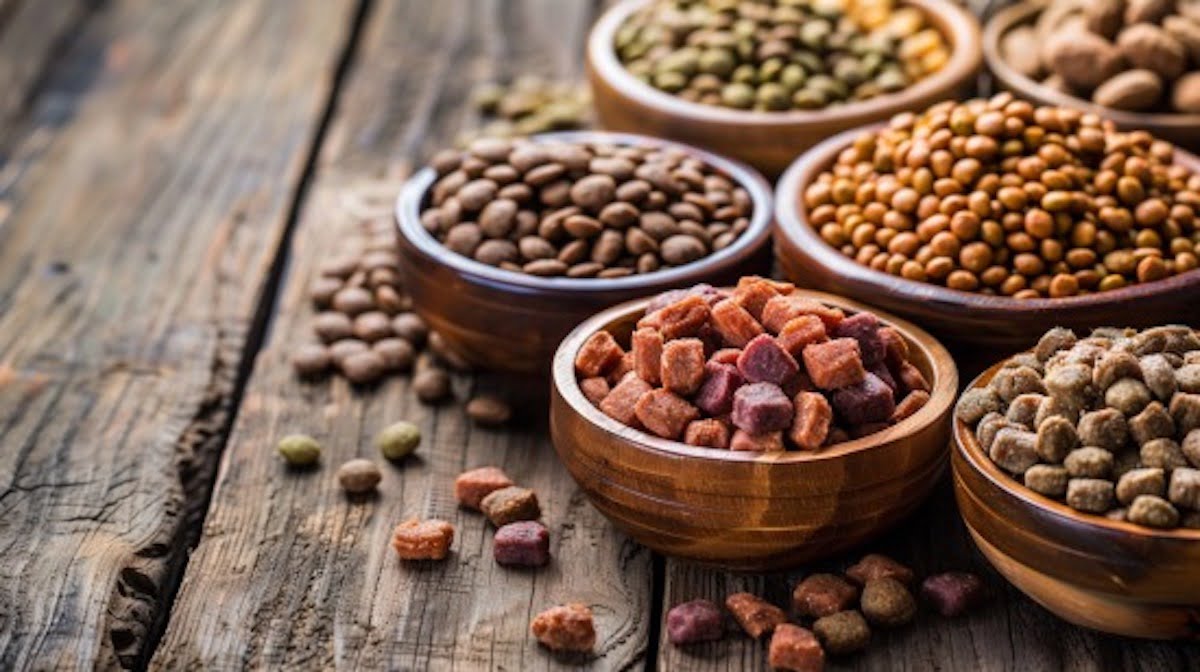Hey there, fellow dog enthusiasts! If you’re like me, you want nothing but the best for your furry best friend. That means digging into the details – like finding the right amount of protein in your dog’s food. After all, our pups need protein to build those strong muscles, keep that coat shiny, and power all those zoomies!
But let’s be honest, the world of dog food nutrition gets a bit confusing. What in the world is “crude protein” anyway? And how much is too much for our canine companions? Don’t worry, that’s where I come in.
What I’ll Cover Today
In this article, we’re going to get to the bottom of protein for pups. Here’s what I’ll walk you through:
- Crude protein – what is it? We’ll break down this term you see on every dog food label.
- AAFCO guidelines: Learn about the recommended protein levels for dogs of different ages and activity levels.
- Your dog’s unique needs: Understand the factors that might mean your dog needs a little more or less protein.
- Signs of imbalance: How to know if your pup’s getting too little or too much protein.
- Choosing the right food: Tips for finding dog foods with the right protein punch.
Why Get This Right?
Finding the right protein balance is like unlocking your dog’s superpower! It’s not just about muscle mass. The right amount of protein helps your dog feel great and look even better. Think healthier skin, a glossier coat, and maybe even a little less shedding. Bonus!

And let’s not forget that the right protein levels can affect your dog’s overall health in the long run. For even more tips on making sure your dog gets the right nutrition, including a deeper dive into protein, be sure to check out our comprehensive dog nutrition guide.
Understanding Crude Protein Quality
Protein Isn’t Just a Number
Alright, dog food detectives, here’s the thing: that “crude protein” percentage on the bag doesn’t tell the whole story. Think of it like reading the calorie count on your food… it doesn’t tell you if those calories are coming from a salad or a slice of cake!
The same goes for your dog’s dinner. It’s not just about how much protein, but also about the quality. What good are tons of protein if your pup’s body can’t easily use it?
Digestibility is Key!
- Here’s the big word: digestibility. This basically means how well your dog’s body can break down the protein in their food and absorb those awesome nutrients. High-quality protein sources are generally more digestible.
All Protein Sources Are Not Created Equal
Let’s be real, there’s a whole range of ingredients that can provide protein in dog food:
- The Champions: Whole meats like chicken, beef, fish, and lamb are generally your A-team. They’re usually highly digestible, meaning your dog gets the most out of them.
- The “Ok” Options: Ingredients like organ meats or eggs can still be decent sources, though often a bit less digestible.
- The Low Performers: Plant-based proteins often have lower digestibility. That doesn’t necessarily mean they’re bad, but something to consider, especially if your pup has a sensitive tummy.
Fancy Table Time!
Want a quick cheat sheet? Let’s break down some common protein sources found in dog food and their typical digestibility:
| Protein Source | Typical Digestibility |
|---|---|
| Chicken | High |
| Beef | High |
| Lamb | High |
| Fish (e.g., salmon) | High |
| Eggs | High |
| Soybeans | Moderate |
| Corn Gluten Meal | Low |
AAFCO: Your Dog Food Guidance
Think of the Association of American Feed Control Officials (AAFCO) as the rulebook for dog food. They set the minimum standards for nutrients, including that all-important crude protein.
The Starting Point
Here’s what AAFCO recommends as the minimum for crude protein on a dry matter basis:
- Puppies: 22% – All that growing needs fuel!
- Adult dogs: 18% – Maintenance mode needs a bit less
But, and this is a big BUT, these are just the bare minimums. Many dogs thrive on a little more protein, depending on their unique needs.
Your Dog is Not a Cookie-Cutter Canine
Each pup is a unique snowflake, wouldn’t you agree? So those AAFCO guidelines are just a starting point. Let’s talk about the factors that might mean your dog needs a protein boost or a slight scaling back.
It’s Not One-Size-Fits-All!
Okay, let’s ditch the idea that “one protein percentage suits every pup.” That’s just not how it works! Several factors can influence just how much protein your best furry friend needs. Let’s break them down.
Age Matters
- Puppy Power: Growing pups need a protein boost! Think of it as building blocks for those growing muscles, bones, and that adorable puppy fluff. They often need a slightly higher percentage of protein in their diet, typically above the AAFCO minimum.
- Golden Oldies: Our senior pups may also need a slight protein increase to maintain muscle mass and support their overall health as they age.
Big, Small, and In-Between Breeds
- Size Matters: Giant breeds sometimes need a bit more protein to support their larger frames. (Fun fact: There’s some debate about this among experts!)
- Working Dogs vs. Lapdogs: Highly active, working dogs put more wear and tear on their bodies. Think of those agility champs and sled dogs! They need more protein for muscle repair and energy.
- The Chill Pup: If your canine bestie is more of a couch potato than an athlete, a lower protein percentage might be just fine to prevent them from packing on extra pounds.

Activity Level is Key
Speaking of those couch potatoes, let’s talk about how much exercise your dog gets:
- Active Adventurers: If your dog’s idea of fun is long hikes or endless fetch sessions, they’ll need more protein to fuel all that activity.
- Leisurely Lovers: Dogs with a more relaxed lifestyle can usually do well on a more moderate protein intake.
Healthy or Not?
- This one’s important: Certain health conditions might mean your dog needs a specially adjusted amount of protein in their diet. For example, dogs with kidney issues may need slightly less protein.
Listen to Your Dog’s Body
Our four-legged friends are pretty good at sending signals when something’s not quite right, including with their protein intake. Keep an eye out for these potential signs.
Signs of Too Little Protein
- Weak and Tired: Low protein can cause muscle loss and make your pup seem less energetic.
- Dull Coat: A shiny coat is a sign of good health, and protein plays a role! When it’s lacking, you might notice a dull or brittle coat.
- Slow Recovery: Protein is crucial for healing. If your dog seems to recover slowly from minor injuries or gets sick often, it could be a red flag.
Signs of Too Much Protein
- Thirsty Pup: Excessive protein can strain the kidneys, making your dog extra thirsty and causing them to pee more often.
- Tummy Troubles: Too much protein can lead to an upset stomach, with potential diarrhea or vomiting.
- Hyperactivity: This is less common, but sometimes a sign of way too much protein.
It’s a Balancing Act
The key is finding the right balance for your dog. Too much or too little protein can both cause trouble!
- Important reminder: If you notice any of these signs, don’t panic. It’s time for a vet visit to rule out any underlying health problems and get personalized recommendations for your pup’s diet.
FAQs
What’s the difference between crude protein and digestible protein?
Crude protein is the total amount of protein in a food. Digestible protein refers to how much of that protein your dog’s body can actually absorb and use. High-quality protein sources (like meat) are typically more digestible.
Can too much protein harm my dog?
Yes! Excessive protein can strain your dog’s kidneys and liver over time. It can also cause tummy troubles, dehydration, and even weight gain. Always discuss the right protein amount for your dog with your vet.
Conclusion
Wow, we’ve covered a lot of ground on our protein quest! I hope you now feel like you have the tools to decode dog food labels and make the best choices for your furry best friend.

Healthy dogs mean happy dogs, and that makes me happy! I’m here to share all the tips for keeping your best furry friend in top shape, from puppyhood to their golden years.


